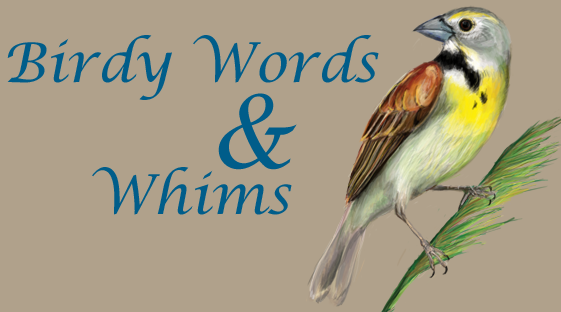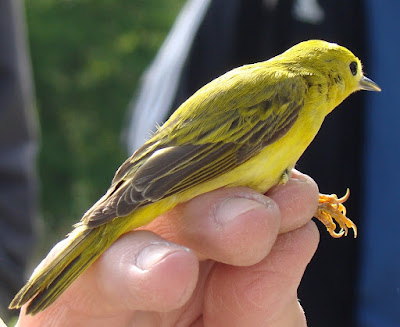Check out these Tree Swallows - Does the male have his wing over the female's shoulder? Click the picture for the huge version. Awww!! Love is in the air.
Anyway, I took a trip to my hometown, Green Bay WI this weekend and happened to hit the jackpot of springtime birding. Of course, expectations were already high, the weather was perfect and the parking lot was full at the
Bay Beach Wildlife Sanctuary. I got there around 7:30 which was after the official Saturday morning birding tour started, but I figured I could do ok on my own. Of course, my mom came to help out and hold the guide book if I ever needed it.
 I already saw 3 warbler species around my parents' yard Saturday morning and I couldn't wait to get out to the sanctuary. Once we got there, this is the first warbler we saw, a Cape May. It was absolutely gorgeous and the first one I have ever seen. Later I would also add Northern Parula and Bay-breasted Warbler to my first-time-ever list.
I already saw 3 warbler species around my parents' yard Saturday morning and I couldn't wait to get out to the sanctuary. Once we got there, this is the first warbler we saw, a Cape May. It was absolutely gorgeous and the first one I have ever seen. Later I would also add Northern Parula and Bay-breasted Warbler to my first-time-ever list.

Shortly after seeing the Cape May, I found this Blackpoll warbler amongst some Yellow-rumps and a Magnolia. After seeing this guy, I could really tell the difference between the blackpoll and the black-and-white warbler (which I also spotted later). The little black cap on the blackpoll is very distinct.
 Obligatory squirrel shot - I love red squirrels and hardly ever see them.
Obligatory squirrel shot - I love red squirrels and hardly ever see them.
 A Blackburnian warbler! He was far away but I managed to get a shot. These guys are very striking with a bright orange breast. Some other warblers I saw that deserve an honorable mention are: Chestnut-sided, Black-throated Green, Yellow, Tennessee, Nashville, Canada Warbler, Northern Parula, American Redstart, and an Ovenbird. That brings the grand total to 18 warbler species in one weekend (in case you weren't keeping track.)
A Blackburnian warbler! He was far away but I managed to get a shot. These guys are very striking with a bright orange breast. Some other warblers I saw that deserve an honorable mention are: Chestnut-sided, Black-throated Green, Yellow, Tennessee, Nashville, Canada Warbler, Northern Parula, American Redstart, and an Ovenbird. That brings the grand total to 18 warbler species in one weekend (in case you weren't keeping track.)
 After a pretty exciting morning, I still had time to check out the American White Pelicans that hang out by the main street bridge in De Pere. They are a pretty cool sight to see if you're used to the typical midwestern birds. These pelicans have only been breeding alongside the Fox River for maybe the last 5ish years. This year there are close to 100 birds in this area. They seem to be doing pretty well for themselves.
After a pretty exciting morning, I still had time to check out the American White Pelicans that hang out by the main street bridge in De Pere. They are a pretty cool sight to see if you're used to the typical midwestern birds. These pelicans have only been breeding alongside the Fox River for maybe the last 5ish years. This year there are close to 100 birds in this area. They seem to be doing pretty well for themselves.


A couple Oriole pictures, male at the top and female with nest material at bottom. Again, orioles were everywhere as they were last weekend. A couple other notable larger birds I saw were Rose-breasted Grosbeaks, Wood Thrushes, Indigo Buntings, and a Scarlet Tanager. I didn't get anymore great pictures of those birds but they sure made for a colorful bird bouquet.
 Here is a Baltimore Oriole nest I spotted at Green Isle Park in Green Bay. They construct beautiful little hanging baskets. This one was kind of out in the open and I heard nest-parasitizing Brown-headed cowbirds nearby so I wish this pair good luck.
Here is a Baltimore Oriole nest I spotted at Green Isle Park in Green Bay. They construct beautiful little hanging baskets. This one was kind of out in the open and I heard nest-parasitizing Brown-headed cowbirds nearby so I wish this pair good luck.
I was sad that I missed banding on Saturday, but it was a pretty successful weekend anyway! I hope they didn't catch too many cool birds without me. The video for the day is a Grey Catbird singing at the Wildlife Sanctuary and the birdy artwork is a Yellow Warbler.

 It was a gusty morning at Biocore Prairie, but fortunately the winds were blowing the birds right into our nets. We had one male Red-winged Blackbird, two Yellow Warblers, a male Common Yellowthroat, Eastern Wood-Pewee, Tennessee Warbler, two Song Sparrows, a Red-eyed Vireo and a Baltimore Oriole. It was great getting a lot of different species that we didn't have last week.
It was a gusty morning at Biocore Prairie, but fortunately the winds were blowing the birds right into our nets. We had one male Red-winged Blackbird, two Yellow Warblers, a male Common Yellowthroat, Eastern Wood-Pewee, Tennessee Warbler, two Song Sparrows, a Red-eyed Vireo and a Baltimore Oriole. It was great getting a lot of different species that we didn't have last week. Here's the first Song Sparrow I've banded this season. I've had a few days in the past where Song Sparrows are the only bird we catch. I think it's more exciting banding sparrows when you get a variety and you get a real close-up look at the differences between the species, but that's just my opinion!
Here's the first Song Sparrow I've banded this season. I've had a few days in the past where Song Sparrows are the only bird we catch. I think it's more exciting banding sparrows when you get a variety and you get a real close-up look at the differences between the species, but that's just my opinion! Here is the Tennesse Warbler we caught. It's hard to tell from the picture but he was a very olivey green color.
Here is the Tennesse Warbler we caught. It's hard to tell from the picture but he was a very olivey green color.










 This American Goldfinch was my first bird of the day. There was a whole flock of goldfinches sitting atop the net, wondering how to save their friend. But this guy was the only one who got stuck. If you see the strange color on his lower beak, we assumed that he had gotten stained by gorging himself on berries.
This American Goldfinch was my first bird of the day. There was a whole flock of goldfinches sitting atop the net, wondering how to save their friend. But this guy was the only one who got stuck. If you see the strange color on his lower beak, we assumed that he had gotten stained by gorging himself on berries. Here I am with the male goldfinch. I was able to extract him from the net by myself. It's really good that I'm getting some practice and feeling more confident doing this. It can be a really tricky and nerve-wracking process!
Here I am with the male goldfinch. I was able to extract him from the net by myself. It's really good that I'm getting some practice and feeling more confident doing this. It can be a really tricky and nerve-wracking process!













 Here is a Baltimore Oriole nest I spotted at Green Isle Park in Green Bay. They construct beautiful little hanging baskets. This one was kind of out in the open and I heard nest-parasitizing Brown-headed cowbirds nearby so I wish this pair good luck.
Here is a Baltimore Oriole nest I spotted at Green Isle Park in Green Bay. They construct beautiful little hanging baskets. This one was kind of out in the open and I heard nest-parasitizing Brown-headed cowbirds nearby so I wish this pair good luck. 
 The Famous.. Garden Birds playing cards! I haven't used them yet, but they are pretty cute. Each card has a different bird on it.
The Famous.. Garden Birds playing cards! I haven't used them yet, but they are pretty cute. Each card has a different bird on it.













 Thanks for reading and I hope you stay tuned for more to come !
Thanks for reading and I hope you stay tuned for more to come !
